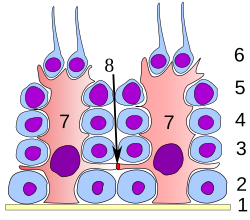精子发生
外观

精子發生(英語:spermatogenesis)是有性生殖的雄性动物的睪丸中,生殖细胞从精原细胞一直发育到成熟的精子的过程。这一过程始于精原干细胞的有丝分裂,邻近生精小管的基底膜。
目的
以人類為例,繁殖跟動植物一樣,需要利用母細胞減數分裂,其後分化成成熟精子。

位置
精子发生过程的位置是男性生殖系统的数个结构。最开始的阶段发生在睾丸,一直到附睾结束。附睾是发展中的精子成熟和储存直到射精的地方。睾丸的生精小管是整个过程的起点,在那里邻近内管壁的干细胞朝着中心分裂—从管壁开始,进行到最内层的部分,即内腔—来生产未成熟的精子。精子成熟过程发生在附睾。
阶段
精子发生過程中會形成以下種類的細胞:
| 细胞类型 | 倍性/染色体数量(人类) | DNA拷贝/染色单体数量(人类) | Process entered by cell |
| 精原细胞 (types Ad, Ap and B) | 倍性 (2N) / 46 | 2C / 46 | spermatocytogenesis(有丝分裂) |
| 初級精母细胞 | 倍性 (2N) / 46 | 4C / 46 | spermatidogenesis (减数分裂1期) |
| 2个次级精母细胞 | 倍性 (N) / 23 | 2C / 46 | spermatidogenesis(减数分裂2期) |
| 4个精细胞 | 倍性 (N) / 23 | 1C / 23 | spermiogenesis |
| 4个游动精子 | 倍性 (N) / 23 | 1C / 23 | spermiation |
| 倍性和染色体在G1期计数, 在DNA合成和分裂之前 | |||
精母细胞发生

精细胞生成
精细胞生成是从次级精母细胞生成精细胞的过程。此过程前已生成的次级精母细胞迅速进入减数分裂II期,分裂产生单倍体精细胞。
精子形成
在精子形成阶段中,精细胞开始长出一条尾部。
塞尔托利氏细胞的角色

影响因素
個體、疾病、壓力等會影響生產速度。
激素控制
精子发生的激素控制随物种而不同。人类精子发生的激素控制机制尚未被完全理解。
参考文献
- The testes and spermatogenesis. University of Wisconsin. 1998 [2006-11-27]. (原始内容存档于2008-06-19).
- Johnson, L; Blanchard, TL; Varner, DD; Scrutchfield, WL. Factors affecting spermatogenesis in the stallion. Theriogenology. 1997, 48 (7): 1199–1216 [2013-11-09]. PMID 16728209. doi:10.1016/S0093-691X(97)00353-1. (原始内容存档于2013-11-09).
- BARDIN CW: Pituitary-testicular axis. In: YEN SS , JAFFEE RB , eds: Reproductive Endocrinology, 3rd ed. Philadelphia: WB Saunders, 1991
- CHAMBERS CV , SHAFER MA , ADGER H , et al.: Microflora of the urethra in adolescent boys: relationships to sexual activity and nongonococcal urethritis. J Ped 110:314-321, 1987
- CZYBA JC , GIROD C: Development of normal testis. In: HAFEZ ESE , ed: Descended and Cryptorchid Testis. The Hague, Martinus Nijhoff, 1980.
- Whitmore WF, Kars L, Gittes RF: The role of germinal epithelium and spermatogenesis in the privileged survival of intratesticular grafts. J Urol 1985;134:782.
外部链接
- Spermatogenesis - male reproductive physiology (页面存档备份,存于互联网档案馆) - Am Fam Physician 2000;62:1095.
- Spermatogenesis animation (页面存档备份,存于互联网档案馆)
